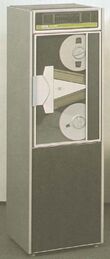Difference between revisions of "TU20 Tape Transport"
m (downsize img) |
(Temporary fix until I can figure out how to provide a default value to a template argument) |
||
| Line 1: | Line 1: | ||
| + | [[Image: TU20.jpg|left|thumb|110px|TU20 drive in rack]] | ||
{{Infobox Tape drive | {{Infobox Tape drive | ||
| − | |||
| name = TU20 | | name = TU20 | ||
| − | |||
| tape speed = 45 ips (Forward/Reverse)<br>160 ips max (Rewind) | | tape speed = 45 ips (Forward/Reverse)<br>160 ips max (Rewind) | ||
| size = 22"W x 27"D x 69"H (in cabinet) | | size = 22"W x 27"D x 69"H (in cabinet) | ||
Revision as of 00:37, 8 February 2024
| TU20 | |
| Tape speed: | 45 ips (Forward/Reverse) 160 ips max (Rewind) |
|---|---|
| Size: | 22"W x 27"D x 69"H (in cabinet) |
| Weight: | 600 lbs (ditto) |
The TU20 was a magnetic tape drive from DEC; it required a controller to connect to its host machine. The transport section was OEMed from the DATAMEC division of Hewlett-Packard. It was used with the PDP-8 (with the TC58 Tape Control Unit), PDP-9 (with the TC59 Tape Control Unit), the PDP-15 (ditto), and the PDP-10 (with the TM10 Magnetic Tape Control).
It could store 5-23 Mbytes on a 2400' 0.5" wide magnetic tape carried on a standard 10-1/2" reel. The basic TU20 supported 7-track operation at 200, 556, and 800 BPI; the TU20A was the 9-track at 800 bpi version.
The tape transport utilizes a single pinch roller capstan, with (somewhat unusual horizontal) vacuum columns. The TU20 drive contains a fair amount of electronics, in the form of FLIP CHIP modules in a 19" wide wire-wrap backplane (mounted horizontally in the base of the cabinet).
External links
- TU20 Tape Transport Maintenance Manual (DEC-OO-I4AB-D)
